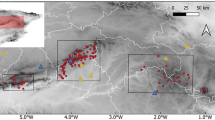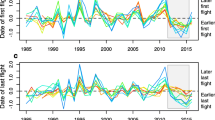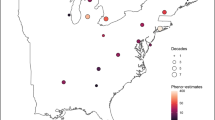Abstract
Although the responses of living organisms to climate change are being widely investigated, little attention has been given to such effects late in the growing season. We studied the late-season flight times of 20 species of butterflies in a geographically limited region, the state of Massachusetts in the USA, by examining change in dates of flight over a 22-year period and in response to average monthly temperature and precipitation. By analyzing the last 10% of each year’s observations reported by observers of the Massachusetts Butterfly Club, we found that seven species remain in flight significantly later into the fall than they did two decades earlier, while two species show reduced late-season flight. Life history characteristics of the species, particularly voltinism and average fall flight dates, influenced whether warmer fall months led to increases or decreases in fall flight. Warmer Novembers often led to later fall flight, and wetter Augusts usually extended fall flight. These results document the effects of climate on late-season flight times of butterflies, add to an understanding of how warmer autumn conditions alter the phenology of different butterfly species, and show the usefulness of citizen science data.





Similar content being viewed by others
References
Altermatt F (2010) Tell me what you eat and I’ll tell you when you fly: diet can predict phenological changes in response to climate change. Ecol Lett 13:1475–1484
Bowden JJ, Eskildsen A, Hansen RR, Olsen K, Kurle CM, Hoye TT (2015) High-Arctic butterflies become smaller with rising temperatures. Biol Lett 11:20150574
Breed GA, Stichter S, Crone EE (2013) Climate-driven changes in northeastern U.S. butterfly communities. Nat Clim Chang 3:142–145
Brooks SJ, Self A, Powney GD, Pearse WD, Penn M, Paterson GLJ (2016) The influence of life history traits on the phenological response of British butterflies to climate variability since the late-19th century. Ecography 39:001–014
Brower LP, Taylor OR, Williams EH, Slayback DA, Zubieta RR, Ramirez ML (2012) Decline of monarch butterflies overwintering in Mexico: is the migratory phenomenon at risk? Insect Conserv Divers 5:95–100
Diamond SE, Frame M, Martin RA, Buckley LB (2011) Species’ traits predict phenological responses to climate change in butterflies. Ecology 92:1005–1012
Dickinson JL, Zuckerberg B, Bonter DN (2010) Citizen science as an ecological research tool: challenges and benefits. Ann Rev Ecol Evol Syst 41:149–172
Ellwood ER, Diez JM, Ibanez I, Primack RB, Kobori H, Higuchi H, Silander JA (2012) Disentangling the paradox of insect phenology: are temporal trends reflecting the response to warming? Oecologia 168:1161–1171
Fenberg PB, Self A, Stewart JR, Wilson RJ, Brooks SJ (2016) Exploring the universal ecological responses to climate change in a univoltine butterfly. J Anim Ecol 85:739–748
Forister ML, Shapiro AM (2003) Climatic trends and advancing spring flight of butterflies in lowland California. Glob Chang Biol 9:1130–1135
Gallinat A, Primack R, Wagner DL (2015) Autumn, the neglected season in climate change research. Trends Ecol Evol. doi:10.1016/j.tree.2015.01.004
Hellman JJ, Pelini SL, Prior KM, Dzurisin JDK (2008) The response of two butterfly species to climatic variation at the edge of their range and the implications for poleward range shifts. Oecologia 157:583–592
Howard E, Davis AK (2015) Tracking the fall migration of eastern monarchs with journey north roost sightings. In: Oberhauser KS, Nail KR, Altizer S (eds) Monarchs in a changing world: biology and conservation of an iconic butterfly. Cornell Univ Press, Ithaca, pp 207–214
IBM Corp (2016) IBM SPSS Statistics for Windows, version 24.0. IBM Corp, Armonk
Kearney MR, Briscoe NJ, Karoly DJ, Porter WP, Norgate M, Sunnucks P (2010) Early emergence in a butterfly causally linked to anthropogenic warming. Biol Lett 6:674–677
Kharouba HM, Paquette SR, Kerr JT, Vellend M (2013) Predicting the sensitivity of butterfly phenology to temperature over the past century. Glob Chang Biol. doi:10.1111/gcb.12429
Klockmann M, Schroder U, Fischer K, Fischer K (2016) Simulating effects of climate change under direct and diapause development in a butterfly. Entomol Exp Appl 158:60–68
Lemoine NP (2015) Climate change may alter breeding ground distributions of eastern migratory monarchs (Danaus plexippus) via range expansion of Asclepias host plants. PLoS One. doi:10.1371/journal.pone.0118614
Mason SC, Palmer G, Fox R, Gillings S, Hill JK, Thomas CD, Oliver TH (2015) Geographical range margins of many taxonomic groups continue to shift polewards. Biol J Linn Soc 115:586–597
Massachusetts Butterfly Club (2016) Massachusetts butterfly flight dates. http://www.naba.org/chapters/nabambc/flight-dates-chart.asp
McLaughlin JF, Hellman JJ, Boggs CL, Ehrlich PR (2002) Climate change hastens population extinctions. Proc Nat Acad Sci U S A 99:6070–6074
Miller-Rushing AJ, Lloyd-Evans TL, Primack RB, Satzinger P (2008) Bird migration times, climate change, and declining population sizes. Glob Chang Biol 14:1–14
Oliver TH, Marshall HH, Morecroft MD, Brereton T, Prudhomme C, Huntingford C (2015) Interacting effects of climate change and habitat fragmentation on drought-sensitive butterflies. Nat Clim Chang 5:941–945
Opler PA, Krizek GO (1984) Butterflies east of the Great Plains. Johns Hopkins Univ Press, Baltimore
Parmesan C (2006) Ecological and evolutionary response to recent climate change. Ann Rev Ecol Evol Syst 37:637–669
Pateman RM, Hill JK, Roy DB, Fox R, Thomas CD (2012) Temperature-dependent alterations in host use drive rapid range expansion in a butterfly. Science 336:1028–1030
Polgar CA, Primack RB, Williams EH, Stichter S, Hitchcock C (2013) Climate effects on the flight period of Lycaenid butterflies in Massachusetts. Biol Conserv 160:25–31
R Core Team (2016) R: a language and environment for statistical computing. R Foundation for Statistical Computing, Vienna
Roy DB, Sparks TH (2000) Phenology of British butterflies and climate change. Glob Chang Biol 6:407–416
Roy DB, Oliver TH, Botham MS, Beckmann B, Brereton T, Dennis RLH, Harrower C, Phillimore AB, Thomas JA (2015) Similarities in butterfly emergence dates among populations suggest local adaptation to climate. Glob Chang Biol 21:3313–3322
Westwood AR, Blair D (2010) Effect of regional climate warming on the phenology of butterflies in boreal forests in Manitoba, Canada. Environ Entomol 39:1122–1133
Williams EH, Stichter SB, Hitchcock C, Polgar CA, Primack RB (2014) Phenological advancement of Lycaenid butterflies in Massachusetts. J Lepid Soc 68:167–174
Zipkin EF, Ries L, Reeves R, Regetz J, Oberhauser KS (2012) Tracking climate impacts on the migratory monarch butterfly. Glob Chang Biol 18:3039–3049
Acknowledgments
We thank the many members of the Massachusetts Butterfly Club for their extensive records of butterfly flight, and we thank Colleen Hitchcock for the discussion in planning the study. We are especially grateful to three anonymous reviewers for their comments that improved the manuscript and to Chris Briggs for statistical advice and assistance.
Author information
Authors and Affiliations
Corresponding author
Ethics declarations
Conflict of interest
The authors declare that they have no conflicts of interest.
Ethical standards
All work reported in this study complies with the laws of the USA.
Welfare of animals
This article does not contain any experimentation with animals performed by any of the authors.
Electronic supplementary material
ESM 1
(DOCX 106 kb)
Rights and permissions
About this article
Cite this article
Zipf, L., Williams, E.H., Primack, R.B. et al. Climate effects on late-season flight times of Massachusetts butterflies. Int J Biometeorol 61, 1667–1673 (2017). https://doi.org/10.1007/s00484-017-1347-8
Received:
Revised:
Accepted:
Published:
Issue Date:
DOI: https://doi.org/10.1007/s00484-017-1347-8




